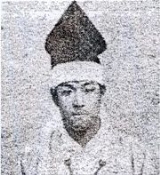
Niwa Nagahiro
Encyclopedia
Viscount was a Japanese daimyo of the early Meiji period
who ruled Nihonmatsu han. The 9th son of Yonezawa lord Uesugi Narinori
, he succeeded to the Nihonmatsu headship in 1868. Nihonmatsu had just lost in the Boshin War
, and as one of the conditions for its surrender to the Imperial Japanese Army
, Niwa Nagakuni
, the previous daimyo, retired. In his place, his adopted son Nagahiro became daimyo, with Nihonmatsu reduced to 50,000 koku
in its holdings (half of what it had previously held). After the domain system was abolished, Nagahiro became a shishaku (viscount) in the new kazoku
system. He was succeeded by his birth brother Nagayasu (Uesugi Narinori's 11th son) in 1886.
|-
Meiji period
The , also known as the Meiji era, is a Japanese era which extended from September 1868 through July 1912. This period represents the first half of the Empire of Japan.- Meiji Restoration and the emperor :...
who ruled Nihonmatsu han. The 9th son of Yonezawa lord Uesugi Narinori
Uesugi Narinori
was a Japanese daimyo of the Edo period, who ruled the Yonezawa Domain. He ruled Yonezawa during the closing years of the Tokugawa shogunate, and was responsible for leading the domain in its fight during the Boshin War of 1868-69. After defeat in the war, he retired in favor of his son Mochinori,...
, he succeeded to the Nihonmatsu headship in 1868. Nihonmatsu had just lost in the Boshin War
Boshin War
The was a civil war in Japan, fought from 1868 to 1869 between forces of the ruling Tokugawa shogunate and those seeking to return political power to the imperial court....
, and as one of the conditions for its surrender to the Imperial Japanese Army
Imperial Japanese Army
-Foundation:During the Meiji Restoration, the military forces loyal to the Emperor were samurai drawn primarily from the loyalist feudal domains of Satsuma and Chōshū...
, Niwa Nagakuni
Niwa Nagakuni
Viscount ; was a Japanese daimyo of the late Edo period who ruled Nihonmatsu han and was famous for his leadership of the domain during the Boshin War.-Biography:...
, the previous daimyo, retired. In his place, his adopted son Nagahiro became daimyo, with Nihonmatsu reduced to 50,000 koku
Koku
The is a Japanese unit of volume, equal to ten cubic shaku. In this definition, 3.5937 koku equal one cubic metre, i.e. 1 koku is approximately 278.3 litres. The koku was originally defined as a quantity of rice, historically defined as enough rice to feed one person for one year...
in its holdings (half of what it had previously held). After the domain system was abolished, Nagahiro became a shishaku (viscount) in the new kazoku
Kazoku
The was the hereditary peerage of the Empire of Japan that existed between 1869 and 1947.-Origins:Following the Meiji Restoration of 1868, the ancient court nobility of Kyoto regained some of its lost status...
system. He was succeeded by his birth brother Nagayasu (Uesugi Narinori's 11th son) in 1886.
Further reading
- Nihonmatsu-han shi 二本松藩史. Tokyo: Nihonmatsu-hanshi kankōkai 二本松藩史刊行会, 1926 (republished by Rekishi Toshosha 歴史図書社, 1973)
- Onodera Eikō 小野寺永幸. Boshin Nanboku Sensō to Tōhoku Seiken 戊辰南北戦争と東北政権. Sendai: Kita no Sha 北の杜, 2004.
- Sugeno Shigeru 菅野与. Ōshū Nihonmatsu-han nenpyō 奥州二本松藩年表. Aizu-Wakamatsu shi 会津若松市: Rekishi Shunjūsha 歴史春秋社, 2004.
External links
- Genealogical Information (in Japanese)
- Concise Biography (in Japanese)
|-

